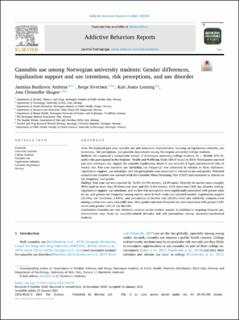| dc.contributor.author | Andreas, Jasmina Burdzovic | |
| dc.contributor.author | Sivertsen, Børge | |
| dc.contributor.author | Lønning, Kari Jussie | |
| dc.contributor.author | Skogen, Jens Christoffer | |
| dc.date.accessioned | 2021-04-23T08:23:02Z | |
| dc.date.available | 2021-04-23T08:23:02Z | |
| dc.date.created | 2021-01-20T10:26:38Z | |
| dc.date.issued | 2021 | |
| dc.identifier.citation | Addictive Behaviors Reports. 2021,13, . | en_US |
| dc.identifier.issn | 2352-8532 | |
| dc.identifier.uri | https://hdl.handle.net/11250/2739275 | |
| dc.description.abstract | Aims
We explored past-year cannabis use and associated characteristics, focusing on legalization attitudes, use intentions, risk perceptions, and possible dependence among Norwegian university/college students.
Methods
We examined a nation-wide sample of Norwegian university/college students (N = 49,688; 67% female) who participated in the Students’ Health and Wellbeing Study (SHoT-study) in 2018. Participants reported past-year substance use, support for cannabis legalization, intent to use cannabis if legal, and perceived risks of weekly use. Past-year cannabis use (including use frequency) was examined in relation to these indicators. Legalization support, use intentions, and risk perceptions were examined in relation to use and gender. Potential cannabis use disorder was assessed with the Cannabis Abuse Screening Test (CAST) and examined in relation to use frequency and gender.
Findings
Past-year use was reported by 15.3% (11.8% women; 22.9% men). Majority of current users (roughly 90%) used no more than 50 times past year, and 6% (3.8% women; 8.5% men) met CAST use disorder criteria. Legalization support, use intentions, and no/low risk perceptions were significantly associated with greater odds of use, and greater use frequency among current users in both crude and adjusted models. Legalization support (23.0%), use intentions (14.0%), and perceptions of no/low risk (29.2%) were also relatively common even among current non-users, especially men. Male gender and more frequent use were associated with greater CAST scores and greater odds of use disorder.
Conclusions
Cannabis use was relatively common in this student sample. In addition to targeting frequent use, interventions may focus on cannabis-related attitudes and risk perceptions among uncertain/uninformed students. | en_US |
| dc.language.iso | eng | en_US |
| dc.publisher | Elsevier Science | en_US |
| dc.rights | Attribution-NonCommercial-NoDerivatives 4.0 Internasjonal | * |
| dc.rights.uri | http://creativecommons.org/licenses/by-nc-nd/4.0/deed.no | * |
| dc.title | Cannabis use among Norwegian university students: Gender differences, legalization support and use intentions, risk perceptions, and use disorder | en_US |
| dc.type | Peer reviewed | en_US |
| dc.type | Journal article | en_US |
| dc.description.version | publishedVersion | en_US |
| dc.source.pagenumber | 8 | en_US |
| dc.source.volume | 13 | en_US |
| dc.source.journal | Addictive Behaviors Reports | en_US |
| dc.identifier.doi | 10.1016/j.abrep.2021.100339 | |
| dc.identifier.cristin | 1875201 | |
| dc.description.localcode | This article is available under the Creative Commons CC-BY-NC-ND license and permits non-commercial use of the work as published, without adaptation or alteration provided the work is fully attributed. | en_US |
| dc.source.articlenumber | 100339 | en_US |
| cristin.ispublished | true | |
| cristin.fulltext | original | |
| cristin.qualitycode | 1 | |

